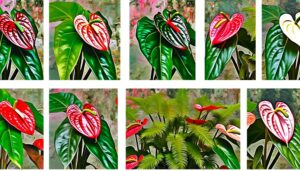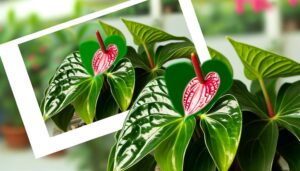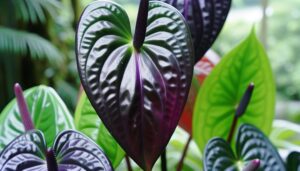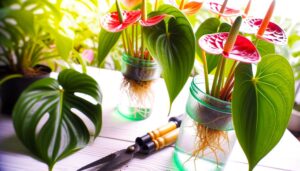Complete Care Guide for Anthurium Green King
To care for your Anthurium Green King, provide bright, indirect sunlight and maintain high humidity levels of 60-80%. Water every 7-10 days using filtered or distilled water, ensuring proper drainage to prevent root rot.
Keep the temperature between 65-80°F, and avoid sudden fluctuations. Use a well-draining soil mix with pine bark, peat moss, and perlite.
Fertilize every 6-8 weeks with a balanced 20-20-20 water-soluble fertilizer at half strength. Prune dead leaves and old flowers with sterilized shears.
For a full guide detailing repotting, pruning techniques, and pest prevention, continue exploring more tips and insights.

Key Takeaways
- Thrives in bright, indirect sunlight; avoid direct sun to prevent leaf damage.
- Maintain high humidity levels of 60-80% and temperature between 65-80°F.
- Water every 7-10 days with distilled, rainwater, or filtered water; ensure proper drainage.
- Use a well-draining soil mix with pine bark, peat moss, and perlite.
- Fertilize every 6-8 weeks with a diluted 20-20-20 water-soluble fertilizer.
Understanding Anthurium Green King
To truly appreciate the Anthurium Green King, you need to explore its unique botanical characteristics and environmental preferences.
This species boasts heart-shaped, glossy leaves with prominent venation, providing a lush, tropical aesthetic.
Native to Central and South America, it’s an epiphyte, meaning it thrives in well-draining, organic-rich substrates.
You should use a mix of orchid bark, perlite, and peat moss to replicate its natural habitat. Keep the soil stays moist but not waterlogged, as root rot can be detrimental.
High humidity, around 60-80%, is crucial for best growth. Placing your plant on a humidity tray or using a humidifier can help achieve this. Additionally, maintain temperatures between 65-80°F to emulate its native, warm environment.
Ideal Light Conditions
To maximize the growth of your Anthurium Green King, place it in an environment with bright, indirect sunlight. Direct exposure to intense sunlight can scorch its leaves, leading to unsightly damage.
An east or north-facing window is ideal for maintaining ideal light conditions.
Indirect Sunlight Preference
Anthurium Green King thrives best when placed in bright, indirect sunlight, mimicking the dappled light conditions of its native tropical habitat.
You’ll want to position your plant near a north or east-facing window, where it can receive filtered light. If natural light is limited, consider using sheer curtains to diffuse the sunlight. You can also use a grow light that replicates these conditions.
Here’s a quick guide:
| Light Source | Recommended Setup | Benefits |
|---|---|---|
| North-facing window | Place 2-3 feet from window | Consistent indirect light |
| East-facing window | Morning light | Gentle, ideal intensity |
| Sheer curtains | Filter direct sunlight | Prevents leaf burn |
| Grow light | Full spectrum, 12-14 hours daily | Year-round consistency |
| Dappled shade | Under larger plants outdoors | Mimics natural habitat |
Avoid Direct Exposure
Direct sunlight can scorch the leaves of your Anthurium Green King, leading to unsightly brown patches and stunted growth.
To achieve ideal photosynthesis without damage, place your plant in bright, indirect light. A north-facing window or a spot shielded by sheer curtains works perfectly.
If you’re using artificial lighting, full-spectrum fluorescent bulbs can mimic natural light effectively. Monitor the light intensity with a light meter, aiming for 1,000 to 2,000 foot-candles.
Avoid placing your Anthurium in deep shade, as low light can hinder its growth and vibrancy. By ensuring the right light conditions, you’ll foster a thriving, lush Anthurium Green King that adds a touch of the tropics to your living space.
Watering Schedule
To maintain the health of your Anthurium Green King, it’s important to establish an ideal watering frequency, typically once a week. Watch for signs of overwatering like yellowing leaves and root rot, which can be harmful.
Use filtered or rainwater to avoid the negative effects of tap water’s chlorine and fluoride.
Optimal Watering Frequency
Maintaining a consistent watering schedule is essential, typically requiring watering every 7-10 days, depending on the ambient humidity and temperature.
You should check the soil’s moisture level by inserting your finger about an inch deep. If it feels dry, it’s time to water.
Use tepid, filtered water to avoid shocking the roots with sudden temperature changes. Make sure your Anthurium Green King is in well-draining soil to prevent waterlogging, which can lead to root rot. Elevate the pot if needed to enhance drainage.
During high humidity, reduce watering frequency as the plant absorbs moisture from the air. Conversely, during dry periods, you might need to water more frequently.
Always adjust based on environmental conditions and plant needs.
Signs of Overwatering
Overwatering can be harmful to your Anthurium Green King, often showing through yellowing leaves, mushy stems, and root rot.
When you overwater, the roots can’t access oxygen, leading to an anaerobic environment conducive to harmful pathogens. To prevent this, make sure the soil is well-draining and use a pot with drainage holes.
Check the moisture level by inserting your finger 2 inches into the soil; if it feels damp, hold off on watering.
Observe your plant closely: wilting despite moist soil, a musty odor, or mold on the soil surface are red flags.
Adjusting your watering schedule and improving aeration can alleviate these issues, promoting a healthier, more resilient Anthurium Green King.
Ideal Water Type
Choosing the correct type of water is crucial for the health of your Anthurium Green King, as tap water often contains minerals and chemicals that can harm the plant.
Go for distilled or rainwater to avoid chlorine and fluoride, which can cause leaf discoloration and root damage. Make sure you water the plant thoroughly, allowing excess water to drain out.
- Distilled Water: Free from harmful minerals and chemicals.
- Rainwater: Natural and nutrient-rich, ideal for plant health.
- Filtered Water: Removes chlorine and heavy metals, safer for your Anthurium.
Water your Anthurium Green King when the top inch of soil feels dry. Overwatering can lead to root rot, so make certain the pot has proper drainage. This method mimics the plant’s natural tropical environment, promoting ideal growth.
Humidity Requirements
To thrive, Anthurium Green King requires a consistent humidity level of at least 60%. You’ll want to monitor humidity with a hygrometer to guarantee ideal conditions.
If indoor air is dry, especially during winter, employ a humidifier to maintain the necessary moisture levels. Misting the leaves can also help, but avoid over-wetting to prevent fungal issues.
Grouping plants or using a humidity tray filled with water and pebbles can naturally elevate humidity. Remember, proper airflow is crucial to prevent mold.
Positioning your Anthurium away from drafts and direct heat sources will help maintain stable humidity. By adhering to these guidelines, you’ll provide an environment where your Anthurium Green King can flourish, granting you the freedom to enjoy its vibrant beauty.
Temperature Guidelines
Maintaining ideal temperature is just as important as humidity for the Anthurium Green King to thrive. Aim to keep the temperature consistently between 65-80°F (18-27°C).
Avoid exposing your plant to sudden temperature fluctuations, which can cause stress and hinder growth.
Consider these critical points to ensure peak temperature conditions:
- Consistent Range: Maintain a stable temperature, avoiding drafts and sudden changes.
- Proximity to Heat Sources: Keep your Anthurium away from radiators, vents, and direct sunlight.
- Night and Day Variation: Allow a slight drop in temperature at night, mimicking natural conditions.
Following these guidelines will help your Anthurium Green King flourish, providing the freedom to enjoy vibrant, healthy plants.
Best Soil Mix
To guarantee your Anthurium Green King thrives, concentrate on creating the perfect soil mix with equal parts of peat moss, pine bark, and perlite for best composition. This blend enhances drainage and aeration, essential for preventing root rot.
Furthermore, enrich the soil with a balanced, slow-release fertilizer to meet the plant’s nutrient needs.
Ideal Soil Composition
For ideal growth, an Anthurium Green King thrives in a well-draining soil mix rich in organic matter and slightly acidic pH levels. You’ll want to use a substrate that guarantees both moisture retention and aeration.
Incorporate components such as:
- Pine bark: Enhances aeration and drainage.
- Peat moss: Provides organic matter and maintains slight acidity.
- Perlite: Improves soil structure and prevents compaction.
These elements create a balanced medium that mimics the plant’s natural epiphytic environment, promoting robust root development and nutrient uptake.
Drainage and Aeration
Anthurium Green King requires great drainage and aeration to thrive, which you can achieve by creating a soil mix that includes components like pine bark, perlite, and orchid bark in specific proportions.
Start with equal parts pine bark and perlite; these provide aeration and drainage, preventing root rot. Add a portion of orchid bark to enhance the mix’s structure.
This combination mimics the plant’s natural epiphytic environment, ensuring roots receive oxygen and moisture without becoming waterlogged.
Regularly check and adjust the soil composition to maintain ideal conditions. Avoid heavy, compact soils as they restrict airflow and water movement, which stifles growth. By using this scientifically tailored mix, you’ll give your Anthurium the freedom to flourish.
Nutrient Requirements
In addition to well-structured drainage and aeration, providing the right nutrients is key to guaranteeing your Anthurium Green King thrives.
Best soil mix is essential for nutrient uptake and plant health. Choose a blend that balances organic matter and aeration, promoting robust root development.
- Orchid bark: Enhances aeration and mimics natural epiphytic growth.
- Peat moss: Retains moisture and provides essential organic matter.
- Perlite: Ensures adequate drainage, preventing root rot.
Incorporate these elements in equal parts to create an ideal environment.
Regularly check pH levels, aiming for a slightly acidic range (5.5 to 6.5).
Fertilize bi-monthly with a balanced, water-soluble fertilizer to maintain nutrient availability.
This mix offers the freedom to let your plant flourish while keeping upkeep manageable.
Fertilizing Tips
To keep your Anthurium Green King thriving, apply a balanced, water-soluble fertilizer every six to eight weeks during the growing season.
Use a 20-20-20 formulation to guarantee the plant receives equal parts nitrogen, phosphorus, and potassium. Dilute the fertilizer to half strength to prevent root burn.
During the dormant period, reduce the frequency to once every three months. Avoid over-fertilizing, as excess nutrients can lead to salt buildup, which stresses the plant. If you notice yellowing leaves or stunted growth, it may indicate a nutrient deficiency or excess.
Flush the soil with water every few months to remove any accumulated salts. Maintaining proper fertilization enhances your Anthurium’s vibrant foliage and overall health.
Repotting Process
When your Anthurium Green King outgrows its pot, it’s important to repot it every two to three years to maintain healthy growth.
Start by selecting a pot that’s 1-2 inches larger in diameter than the current one. Use a well-draining, airy soil mix to prevent root rot and promote proper aeration.
Gently remove the plant from its old pot, being careful not to damage the roots. Place it in the new pot, fill with soil, and water thoroughly.
- Choose a pot with drainage holes to prevent water buildup.
- Add orchid bark or perlite to enhance soil aeration.
- Repot during the growing season for best root establishment.
- Repotting promotes the thriving of your Anthurium Green King in its living environment.
Pruning Techniques
After repotting, the next step in ensuring your Anthurium Green King’s health is mastering the proper pruning techniques to promote vigorous growth and prevent disease.
Start by using sterilized pruning shears to remove any yellowed or dead leaves, as these can harbor pathogens.
Cut back leggy stems to encourage a fuller appearance and trim off any flowers past their prime to redirect energy to new growth.
Always make clean cuts close to the base, ensuring you don’t damage healthy tissue.
Regular pruning not only enhances aesthetic appeal but also improves air circulation around the plant. Remember, avoiding over-pruning is essential; excessive trimming can stress the plant.
With these techniques, you’ll maintain a thriving and resilient Anthurium Green King.
Pest Prevention
Maintaining a pest-free Anthurium Green King involves vigilant monitoring and adopting integrated pest management strategies to address common threats like aphids, spider mites, and scale insects.
Regularly inspect your plant for any signs of infestation. Use a magnifying glass to spot tiny pests and act immediately if you detect any.
- Biological control: Introduce beneficial insects like ladybugs or predatory mites that naturally prey on these pests.
- Mechanical control: Gently wipe leaves with a damp cloth to physically remove pests and their eggs.
- Chemical control: Apply horticultural oils or insecticidal soaps, ensuring to follow the manufacturer’s instructions for safe and effective use.
Common Issues
Anthurium Green Kings may encounter common issues like root rot, leaf discoloration, and slow growth, each requiring specific care adjustments to resolve.
Root rot typically results from overwatering or poorly draining soil. Make sure you use a well-aerated potting mix and allow the soil to dry between waterings.
For leaf discoloration, examine light levels; yellowing often indicates too much direct sunlight, while pale leaves suggest inadequate light. Adjust your plant’s position accordingly.
If slow growth is your problem, consider nutrient deficiencies. Employ a balanced, water-soluble fertilizer monthly during the growing season.
Propagation Methods
To propagate an Anthurium Green King successfully, you’ll primarily use two methods: division and cuttings.
For division, gently separate the root clumps ensuring each section has roots and at least one healthy stem. Plant these divisions in well-draining soil.
For cuttings, select a healthy stem, cut below a node, and place it in water or a moist growing medium until roots develop.
Division: Ideal for established plants, promotes vigorous growth.
Cuttings: Great for rapid multiplication, easy monitoring of root development.
Optimal Conditions: Maintain high humidity and indirect light for best results.
Conclusion
You’ve mastered the essentials of Anthurium Green King care, but there’s one final secret to reveal.
Imagine a plant thriving beyond your expectations, its leaves glistening with importance. What’s the key?
It’s a delicate balance of light, water, humidity, and temperature, all meticulously managed.
Now, armed with expert knowledge and practical advice, you’re poised to unveil the full potential of your Anthurium Green King.
Will you rise to the challenge and achieve the extraordinary?






